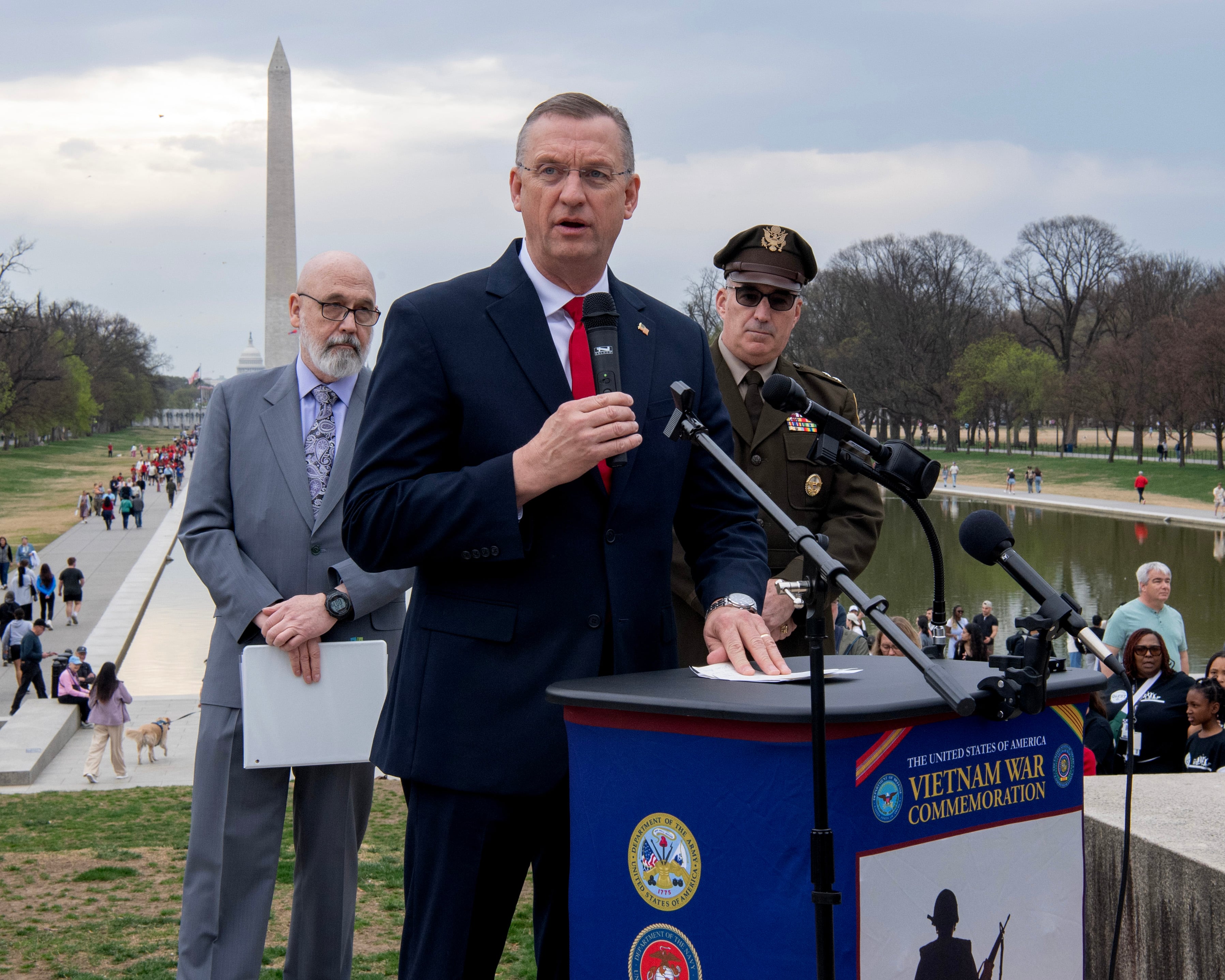WASHINGTON — This year, the Pentagon’s top artificial intelligence office kicked off its first joint war fighting initiative, realigned the organization to meet new department needs and got a new director.
If the fiscal 2021 defense policy bill, known as the National Defense Authorization Act, is signed into law, the department’s Joint Artificial Intelligence Center, will gain acquisition authority, a board of advisers and report up to the deputy secretary of defense, elevating the JAIC in the Pentagon’s hierarchy. In the upcoming year, the JAIC will continue to reach out to components across the department to accelerate the adoption of artificial intelligence across the enterprise.
In a recent Removing Stovepipes webinar with C4ISRNET, Greg Allen, the JAIC chief of strategy and communications, discussed the future of the AI hub and the ongoing progress on joint war fighting activities.
This transcript has been edited for clarity and brevity.
C4ISRNET: This year the office pivoted from JAIC 1.0 to JAIC 2.0. Can you talk about that change and what it means for the department?
Allen: I think this is fundamentally good news because that transformation from JAIC 1.0 to JAIC 2.0 is centered around the progress that the department has made. The JAIC was established to be the focal point of the DoD AI strategy and the engine of the DoD’s AI transformation. Well, a lot of progress has been made in the past two years. And so the types of things that the Department of Defense needs from the Joint AI Center are also changing. When we got started in 2018, there was only a handful of projects that were trying to use AI in sort of any kind of operational sense — Project Maven being the most well-known example — and the rest of AI efforts across the DoD were primarily at the basic research stage without a clear path into operational use.
The great news is that now there’s a lot of exciting projects across the department in each of the armed services. In U.S. [Special Operations Command], the starting point for a lot of organizations has already been reached. And so now they’re at a greater degree of maturity. Now, of course, there are plenty, really an endless number, of organizations throughout the Department of Defense who are just getting started or have not even gotten started with the Department of Defense. But there are now examples of programs being run well, in each of the services, and that’s great news.
C4ISRNET: If this year’s National Defense Authorization Act is signed into law, the JAIC will have acquisition authority. What does that mean for the JAIC?
Allen: First and foremost, this helps us move faster. If you have your own acquisition authority, then you are probably your own top priority. Of course, the contracting offices that we leverage, some of them are terrific partners, but they also have a larger customer base than just the Joint AI Center. And so it’s not always possible to make them understand that you should be at the top of the priority list for you know the kinds of challenges you can imagine them having.
The second thing that it helps us do is that one of the functions that JAIC is hoping to perform on behalf of the department is getting contract vehicles out there that are relevant to AI efforts across the Department of Defense. A great example of this is a contract vehicle that we’re hoping to put together related to testing and evaluation. Some parts of testing and evaluation are unique and specific to every unique type of AI project. But many aspects of them are common across different types of efforts, whether that’s a computer vision effort, a natural language processing effort, or some other type of AI-enabled capability.
The nice thing is that if you can get these testing and evaluation functions specified in contract performance of work statements. Then [because of] what the JAIC has learned by executing its projects over the past two years, we can actually codify that and contract vehicles that reflect our contracting best practices, preserving government ownership rights where appropriate, making sure that the contractor is incentivized by certain types of financial incentives and not by other types of financial incentives, we can take what we’ve learned in terms of best practices for AI contracting and plug that into contract vehicles that now other organizations throughout the DoD can benefit from, so that they don’t have to start from scratch when they’re doing their own contracting efforts. They can benefit from what we’ve already learned.
C4ISRNET: Under the defense policy bill, the JAIC will report directly to the deputy secretary of defense and receive a board of advisers. It seems like the JAIC is starting to get the resources it needs to be successful. Is 2021 viewed as a ‘big’ year internally?
Allen: Yeah, I would say, every year has felt like, ‘OK, it couldn’t possibly be the case that next year would be a bigger deal than what we went through the previous year.’ Because we’ve grown from, as I said, in 2018 really just an idea and a handful of people to a really large organization with an enormous mandate and enormous breadth of activities underway. But the three points that you made, it’s rooted in a current National Defense Authorization Act ... if that becomes law, that is obviously an enormous increase, perhaps not in responsibility, because our responsibilities have basically remained the same, but an enormous increase in the in the suite of tools and authorities that we might have in order to help transform the department.
That would obviously, I think, prove myself wrong yet again. And yes .... 2021 probably would be the most instrumental year in the in the organization’s history.
C4ISRNET: One of the most exiting JAIC efforts that started in 2020 was the joint war fighting network. What progress was made this year and where will that go moving forward?
The great news is that in May 2020, we awarded the prime contract vehicle for our joint war fighting initiative. And that effort, which has a ceiling value of $800 million, allows us a great deal of flexibility in executing the portfolio of projects under the joint warfighting initiative. ... There are other efforts going around, beyond just automating and making ISR more autonomous. There’s other efforts going on around Joint All-Domain Command and Control. The JAIC is actually heavily involved in the sort of AI-enabled workstreams related to the JADC2 effort that you’ve all heard so much about. We have a great suite of partners across the Department of Defense and making that happen. And I would say that the joint war fighting mission initiative is really underway in development and has some exciting capabilities already sort of in the testing stages.
C4ISRNET: With the pivot to JAIC 2.0 and the new authorities you’re going to have in the upcoming year, how should we gauge the success of the JAIC now? What are some of the metrics we should be looking for?
Allen: Well, I think the metrics for individual programs might look a little bit different from the metrics and the organization as a whole. I’ll start by talking about some of the metrics for the programs. In our predictive maintenance effort, one of the things that we try and look at is aircraft uptime. Because if aircrafts are being saddled, spending half of their operational lifetime in maintenance depots, well, that’s quite unfortunate. If you can reduce that time, it’s the sort of functional equivalent of buying new aircraft. So in that case, a key metric for that program might be: Does this actually drive additional uptime for the aircraft?
In other parts of our programs, which are dedicated to the financial performance of the Department of Defense and the financial management of the DoD, it might really be sort of $1 saved, or time and productivity gains by the employee.
But for the JAIC as a whole, our goal is to drive the transformation across the entire Department of Defense, which is, of course, an extraordinary mandate. And so what we’re trying to understand is how many policy barriers did we lower for the DoD that made it possible for them to accelerate their AI adoption faster, or in the case of the Joint Common Foundation, which is designed not to lower policy barriers, but to lower technical barriers. It might be something sort of like user adoption — How many folks are actually using the JCF, and how many programs have their primary development activities occurring on the JCF?
Andrew Eversden covers all things defense technology for C4ISRNET. He previously reported on federal IT and cybersecurity for Federal Times and Fifth Domain, and worked as a congressional reporting fellow for the Texas Tribune. He was also a Washington intern for the Durango Herald. Andrew is a graduate of American University.





